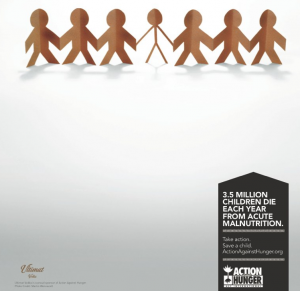How to fail to motivate your audience to take action
This campaign using print ads from from Action Against Hunger (AAH) is a great example of how to fail to motivate your audiences to take action that will benefit your cause.
- Written by
- Nancy Schwarz
- Added
- January 30, 2013

The first ad (see right) features a row of paper dolls, with one figure much thinner than the others, but no clear call to action. The second features a box with a mini pizza inside, which is much smaller than most of us are used to. It highlights that, each year, 3.5 million children under five die because they don’t have enough to eat. Rather than tell readers how to stop this, then and there, they are instead directed to AAH’s website. Or they can make a small donation by text

The ads were designed, pro bono, by G2 USA and will run in high-end consumer magazines including Esquire, Saveur and Harper’s Bazaar. Ultimat Vodka is AHH’s partner and paid for the space – pricy, believe me. Stylistically they’re much like the consumer ads in these types of magazine – spare, graphically compelling, more about aesthetics than anything else.
However, I’m not convinced that they will move anyone to action. The following seven steps are more likely to succeed.
1. Be concrete and specific. Abstraction is deadly.
These ads are abstract and highly stylised, typical of high-end consumer advertising. They mimic the look and feel of what I promise you most of the other ads in these magazines look like, so are easy to miss.
A concept, or abstraction, is far harder to grasp than a story about an individual like you or someone you know. It is a burden on the reader who is just flipping through. Make it easy for folks to get the idea. Plus, pizza is not nutritious, neither is vodka!
2. Feature an individual, rather than a group or, far worse, daunting statistics.
Stats on the enormity of problems like child malnourishment (3.5 million children under five perish every year from poor nutrition) are overwhelming and seem insurmountable. They tend to generate the response: well, I can’t do anything about a problem that’s so huge.
Instead, feature one child who has been restored to health through proper nutrition. It is far easier for someone to relate to a single individual, easier even than a small group of kids. Think about how you relate to people when speaking to a group of 10 versus a one-to-one conversation.
3. Avoid a negative image, for instance a starving child.
Focus on a positive story – with specifics – of someone whose life is better as a result of your organisation’s work.
Bring her to life with a photo. Add specific details and give her a name, Anna say, and tell how she has been restored to health and what her day is like now – the ‘after’.
Now, everyday after school, Anna plays football with the other girls and boys in her village, until her grandmother chases her in to sweep the hut, or get dinner started for her four younger brothers and sisters.
It’s details like this that make Anna’s story real and enable your prospects to relate this story to the children in their lives.
4. Write to a single person, not the many you hope to motivate to act. This transforms the interchange to a one to one, more conversation than lecture.
The ads featured here seem to be written to the ‘general public’. Can you imagine speaking the words of either one? You’d never do it.
Keep a single member of your target audience, let’s call her Judy, clearly in mind as you craft your concept and content, Judy’s face, wants, values, schedule. Crafting a personality is a valuable and easily doable way to close the gap between you and your target audiences. It’s also a good way to get to know them so you can shape your messages most effectively. Here’s my how-to guide to creating a persona.
5. Reach out to Judy’s heart first, head second.
The ads are all head, with their abstract imagery and their stats. They are designed to involve a reader via logic.
You'll be much more successful at engaging Judy through emotion (so she can immediately gauge whether there is a match, or not). Her emotional connection (or lack of) will direct her rational response.
6. Emphasise a clear, easy-to-do call to action.
The paper doll ad has no call to action. The pizza ad features a call to action but it’s in small type and the last element in the text. You really have to work to find it.
Any communication without a clear, doable call to action is a waste. You don't have to motivate Judy to give, sign up, or volunteer in any one call to action, but if you want her to move to the next step you have to ask her to do so. And you have to make it easy for her to find and digest what it is you want her to do – large and stated simply is the best way.
7. Start at the end and work backwards. What is the benchmark you’re trying to hit with the specific marketing project you're working on now?
I’m unsure what AAH is going to accomplish with these ads. Building awareness is a valid high-level goal, but is not a benchmark – it can't be measured.
There is a chance that AAH will bring folks in the door for the first time, but if they don’t text that $10 contribution there’s no way that AAH can follow up these potential supporters.
I want to emphasise that this ad space was an opportunity that AAH was right to accept – premium timing in premium media.
It’s often challenging to direct pro bono contributions, especially on the creative side. These ads focus on abstract images rather than starving children and many readers are unlikely to have seen anything like them before from a nonprofit.
However, because they are similar to all the consumer ads that run in those media they are likely to be overlooked. I see many nonprofit campaigns that are original, sophisticated and effective – in imagery and content – without using the ‘starving child’ approach.
Do these ads work to engage you? Would you be motivated to visit the AAH website or make a text donation? If not, how would you increase the effectiveness of these ads to motivate action? Please let us have your comments.
















